Drillhole Map
Surfer allows you to create 2D maps and 3D models of the path and shape of drillholes, boreholes, shafts, wells, and tunnels to help you build models of those objects. All of these types of data can be displayed as lines and symbols on a 2D map or as shaped 3D cylinders in a 3D model. Using interval data, Surfer can also display a 3D segmented view with a color scale. For example, if your data contains contaminant or deviation data, you can model those aspects in 3D in different colors and shapes along the path of the drillhole, well, or borehole. You can create labels using values in your data files. To help visualize and share these maps and 3D models, export 2D and 3D images to other applications or use the Surfer plot window or the 3D view window to dynamically view the borehole, drillhole, or well paths.
This help topic uses sample drillhole data to walk you through the process of defining both 2D and 3D drillhole maps. You can add drillholes to a new map or to an existing map. Use the Home | New Map | Specialty | Drillhole command to create a new map with a drillhole layer or use the Home | Add to Map | Layer | Drillhole or Map Tools | Add to Map | Layer | Drillhole command to add a drillhole layer to an existing map.
After creating a drillhole layer, you can view it in 3D, Add a Drillhole Layer, define 2D properties, and define 3D properties.
This help topic contains the following main sections:
Drillhole Data Requirements
The data to create a drillhole map include required collars data, and optional survey, interval and point data. In addition to drillhole depth and path data, other data considerations include having supporting values in the point and interval data to map different aspects of your drillhole, borehole, or well (for example, various mineral concentrations). Our sample data include information about TiO2 and MnO, which are shown in the example images in the 3D drillhole help topic. The following sections define the types of data that Surfer needs to create a drillhole layer and the types of data that Surfer can use to enhance the 3D modeling of drillholes and boreholes.
Note: The data below are examples (from C:\Program Files\Golden Software\Surfer\Samples\SampleDrillholeData.xlsx), your data column names may vary. The drillhole or borehole identifier (listed as ID or Hole Id in the examples) is a required column for any imported data table so that Surfer can link all related data to the same drillhole or borehole.
Collars Data
Collars data should have information about the drillhole or borehole, such as Hole ID (name), East (X) coordinate, North (Y) coordinate, elevation, starting depth, ending depth, azimuth, and inclination. The Hole ID, East (X), and North (Y) coordinate fields are required for this table type. Inclination and azimuth data can be used to calculate true vertical depth for deviated paths. This table can have multiple rows, but Hole IDs must be unique. A collars table is required unless you import a LAS (log-ascii) file as interval and point data.
Example Collars Data
| ID | Easting | Northing | Elevation |
| MW-1 | 595299 | 3968125 | 2145 |
| MW-2 | 595203 | 3968210 | 2145 |
| MW-3 | 595176 | 3968113 | 2145 |
Example Collars Data Definitions
|
Hole ID |
Contains the borehole or drillhole identifier. |
Required |
|
Easting |
Contains the X value, easting, longitude, or other horizontal location value of the borehole or drillhole. |
Required |
|
Northing |
Contains the Y value, northing, latitude, or other vertical location value of the borehole or drillhole. |
Required |
|
Elevation |
Contains the Z value or elevation of the borehole or drillhole. |
Optional |
|
Starting Depth |
Contains the starting Z value for the borehole or drillhole in depth or elevation units. Keep in mind that starting depth is not the same as elevation. |
Optional |
|
Ending Depth |
Contains the ending Z value for the borehole or drillhole in depth or elevation units. |
Optional |
|
Inclination |
The angle the borehole or drillhole is oriented, in degrees. Inclination varies from 0 to 180. 0 indicates vertical pointing down, 90 indicates horizontal, and 180 indicates vertical pointing up. When recorded in a collars table, the azimuth and inclination apply to the entire borehole or drillhole length. Negative and positive inclination values are treated the same for depth calculations. A negative inclination changes the direction (azimuth) to the opposite of the similar positive inclination. For example, the azimuth value of 90 and inclination of 45 describes the same orientation as the azimuth value of 270 and inclination of -45 degrees. Both combinations describe an eastward direction at 45 degrees down from the horizontal plane. |
Optional |
|
Azimuth |
The compass orientation of the borehole or drillhole. Azimuth is in degrees and varies from 0 (true vertical north) to 360. When recorded in a collars table, the azimuth and inclination apply to the entire borehole or drillhole length. |
Optional |
Survey Data
Optional survey data should have information about the orientation of the drillhole, such as Hole ID, depth, azimuth, and inclination. This table can have multiple rows with the same Hole IDs.
Example Survey Data
| ID | MD | Azimuth | Inclination |
| MW-1 | 0 | 370 | 44.62 |
| MW-1 | 20 | 370 | 44.89 |
| MW-2 | 0 | 315 | 45.44 |
Example Survey Data Definitions
|
Hole ID |
Contains the borehole or drillhole ID. |
Required |
|
Depth |
Contains the depth or elevation for the recorded deviation. |
Required |
|
Inclination |
The angle the borehole or drillhole is oriented in degrees. Inclination varies from 0 to 180. 0 indicates vertical pointing down, 90 indicates horizontal, and 180 indicates vertical pointing up. When recorded in a survey table, the azimuth and inclination apply from the depth to the next recorded depth. |
Required |
|
Azimuth |
The compass orientation of the borehole's or drillhole's deviation. Azimuth is in degrees and varies from 0 (true vertical north) to 360. When recorded in a survey table, the azimuth and inclination (or dip) apply from the depth to the next recorded depth. |
Required |
Intervals Data
Optional interval data should have actual down hole information in one or more data files (e.g., XLSX, DAT, and CSV) or LAS files. LAS files import both the downhole data and the collars information. Interval data can have multiple rows with the same Hole IDs.
Example Intervals Data
| ID | From | To | TiO2 | MnO |
| MW-1 | 10 | 30 | 2.903 | 0.302 |
| MW-1 | 20 | 40 | 2.915 | 0.299 |
| MW-1 | 40 | 60 | 2.83 | 0.282 |
Example Intervals Data Definitions
|
Hole ID |
Contains the borehole or drillhole ID associated with the interval. |
Required |
|
From |
Contains the top depth or elevation of the recorded parameter. |
Required |
|
To |
Contains the bottom depth or elevation of the recorded parameter. |
Required |
|
Parameter(s) |
One or more columns that contain information, such as contamination, chemical concentration, etc. The parameter value is recorded across at the interval. |
Optional |
Points Data
Optional point data should have actual down hole information in one or more data files (e.g., XLSX, DAT, and CSV) or LAS files. LAS files import both the downhole data and the collars information. All variable information relates to that specific depth. Points data can have multiple rows with the same Hole IDs.
Example Points Data
| ID | Depth | TiO2 | MnO |
| MW-1 | 10 | 2.903 | 0.302 |
| MW-1 | 30 | 2.915 | 0.299 |
| MW-1 | 50 | 2.83 | 0.282 |
Example Points Data Definitions
|
Hole ID |
Contains the borehole or drillhole ID associated with the depth. |
Required |
|
Depth |
Contains the depth or elevation of the recorded parameter. |
Required |
|
Parameter(s) |
One or more columns that contain information, such as contamination, chemical concentration, etc. The parameter value is recorded at the depth. |
Optional |
Create a Drillhole Map
- In a new plot window click the Home | New Map| Specialty | Drillhole command. A Drillhole Data Import dialog appears.
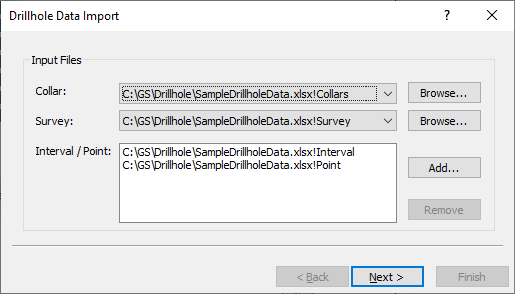
Example Drillhole Data Import data selection dialog using SampleDrillholeData.xls
-
In the Drillhole Data Import dialog, click the Browse and Add buttons to select each of the drillhole data files (collar and optional survey, interval, and point data), and then click Next to open the next Drillhole Data Import dialog. A Drillhole Data Import dialog will appear for each data file selected to be imported. The top section contains a table of the selected data source (Source Fields) and the bottom section contains the mapping of that data source to the table structure (Table Fields) that Surfer will use to create the drillhole map.
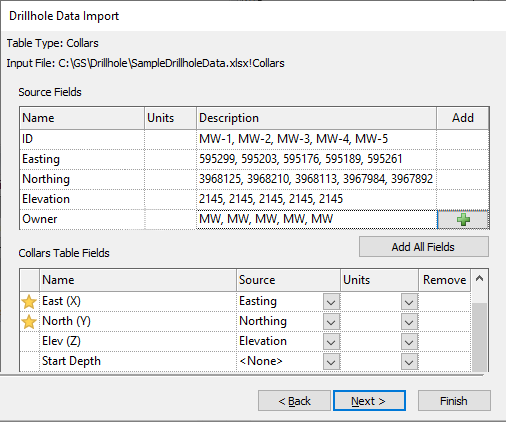
Example Drillhole Data Import dialog for collars data using SampleDrillholeData.xls
-
To import collars or survey data from a Drillhole Data Import dialog:
Note: If both the collars and survey table have azimuth and inclination data, Surfer will use the survey table data. If neither the collars nor the survey data has azimuth or inclination data, then Surfer will assume that the hole is vertical.
- In the Table Fields section, assign a Source field to each Name field. Rows marked with a
 are required. If a source field is not assigned to a predefined, non-required table field, the table field can be left empty (<None>) and have no values imported.
are required. If a source field is not assigned to a predefined, non-required table field, the table field can be left empty (<None>) and have no values imported. - Use the Units fields to define the units for source data. If Units are defined in the source field, the value will automatically be added to the selected table field. If needed, data conversion will occur for the selected unit of the table field. The select units will also show in the Drillhole Manager.
- Click the
 button next to any additional data in the Source Fields section to import that data or click the Add All Fields button to add all data. For any additional rows that were added to the Table Fields section, click the
button next to any additional data in the Source Fields section to import that data or click the Add All Fields button to add all data. For any additional rows that were added to the Table Fields section, click the  button to not import that data. Any data not listed in the Table Fields will not be imported.
button to not import that data. Any data not listed in the Table Fields will not be imported. - After associating the Name to the Source data and defining any Units, click Next to display the next data import dialog.
- In the Table Fields section, assign a Source field to each Name field. Rows marked with a
-
If interval or point data were selected to be imported, a Drillhole Data Import dialog appears for every data source. If the imported data are interval data, click Interval (From/To) Data. If the imported data are point data, click Point (Depth) Data. Interval data usually has rows with Hole ID, From, and To, and point data will have Depth data.
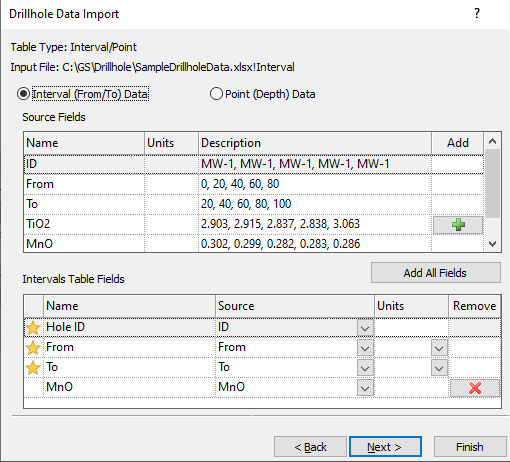
Example interval data Drillhole Data Import dialog.
- In the Table Fields section, assign a Source field to each Name field. Rows marked with a
 are required. If a source field is not assigned to a predefined, non-required table field, the table field can be left empty (<None>) and have no values imported.
are required. If a source field is not assigned to a predefined, non-required table field, the table field can be left empty (<None>) and have no values imported. - Click the
 button next to any additional data in the Source Fields section to import the data or click the Add All Fields button to add all data. For any additional rows that were added to the Table Fields section, click the
button next to any additional data in the Source Fields section to import the data or click the Add All Fields button to add all data. For any additional rows that were added to the Table Fields section, click the  button to not import that data.
button to not import that data. - After associating the Name to the Source data and defining any Units, click Next. If additional imported data need to be defined, another Drillhole Data Import will appear.
- In the Table Fields section, assign a Source field to each Name field. Rows marked with a
-
If one or more LAS files were selected to import, each LAS file will import data into the Collars and Points tabs in the Drillhole Data Import dialog for LAS files. The Collars tab is similar to the collars table Drillhole Data Import dialog described above and takes data from the well information block and the parameter information block in the LAS file. The Points tab takes data from the curve information block in the LAS file.
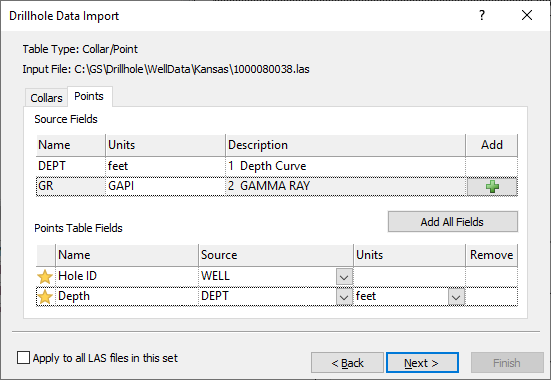
Example Points tab for LAS data import in the Drillhole Data Import dialog
- In the Table Fields section, assign a Source field to each Name field. Rows marked with a
 are required.
are required. - If all LAS files have the same data format, check the Apply to all LAS files in this set check box to apply this data import definition to all LAS files selected to be imported.
- Click the
 button next to any additional data in the Source Fields section to import that data or click the Add All Fields button to add all data. For any additional rows that were added to the Table Fields section, click the
button next to any additional data in the Source Fields section to import that data or click the Add All Fields button to add all data. For any additional rows that were added to the Table Fields section, click the  button to not import that data.
button to not import that data. - After associating the Name to the Source data and defining any Units, click Next to display the next data import dialog.
- In the Table Fields section, assign a Source field to each Name field. Rows marked with a
-
After defining all imported data, the final Drillhole Data Import dialog appears.
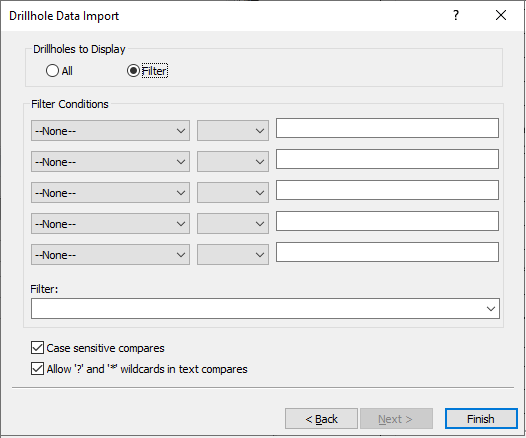
Example Drillhole Data Import filter dialog.
- Under Drillholes to Display, either click All to display all imported drillhole data on the map or click Filter to filter the data to only display a filtered group of drillholes. Use the five Filter Conditions rows to build a filter using fields in the collars table. Click a filter to view or select a previously used filter. If you choose to display all drillholes, you can still filter the display of drillholes using the Drillholes to display property on the General page of the drillhole layer properties.
- The Case sensitive compares and Allow ? and * wildcard in text compares options control how text is compared in the query.
- When the Case sensitive compares check box is checked, the text returned by the filter conditions must have the same case.
- When the Allow ? and * wildcard in text compares check box is checked, a ? can be used to represent any single character and an * can be used to represent a group of characters.
- After defining any needed filters, click the Finish button to create and display the drillhole map.
-
After creating a drillhole map, view a 3D Drillhole Properties, define drillhole properties, Add a Drillhole Layer, or use the Drillhole Manager to manage imported data.
Add a Drillhole Layer
To add a drillhole layer to an existing map:
- Select the map and click Home | Layer | Add to Map | Drillhole or right click over the map layer and select Add to Map | Drillhole.
- If drillhole data has already been imported into the plot document, then the New Drillhole Layer dialog appears.
- If you have new drillhole data you want to display in the new layer, click the Add New Data button to display the Drillhole Data Import dialog. Follow the steps above in the Create a Drillhole Map section, beginning with Step 2.
- If you want to use the same drillhole data to create the new layer, perhaps using different filter conditions, select the desired settings under Drillholes to Display and Filter Conditions and click OK.
- If drillhole data has not already been imported into the plot document, then follow the steps above in the Create a Drillhole Map section, beginning with Step 2.
Note: When adding new drillhole data, you may receive a warning about adjusting map limits to include all data. If you select to adjust the map limits, and then decide to not include the new data, you can readjust the map limits to the original data (see the Limits Properties help topic).
Tips and Hints
You can create a 3D model of vertical drillholes or boreholes using just collars data, if your collars data include ending depth values. The example below shows the first four columns of the collar data in the sample data file, with added end depth values (shown in blue). During the data import of the collars data, associate the collars table End Depth field with the end depth values in your collars data. You can also associate the collars Start Depth field to start depth values in your data. If you don't have or don't associate start depth data, Surfer will use a start depth of 0.
Example collars data with added EndDepth values:
ID Easting Northing Elevation EndDepth MW-1 595299 3968125 2145 690 MW-2 595203 3968210 2145 670 MW-3 595176 3968113 2145 500